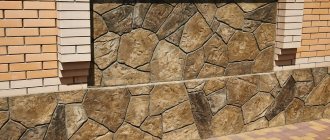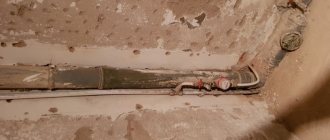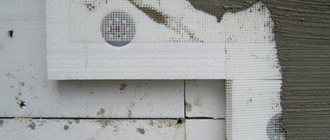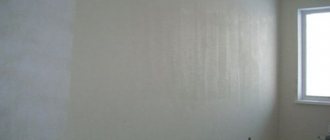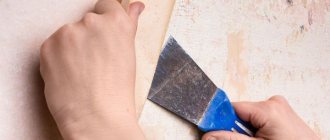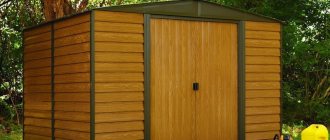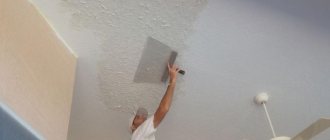Home » Building a house » Headings » Walls
Alexander Korovaev 08/02/2019
8127 Views
Every homeowner sooner or later faces renovations. And, as you know, it starts from the walls. The better they are prepared, the better the final result will be.
All further work depends on how competently all the internal surfaces of the house are plastered - the entire appearance of the room directly depends on this important stage of construction.
How to place beacons under plaster is the topic of this article. At first glance, there is nothing complicated here, but this is not entirely true - you cannot do without knowledge and practical skills developed by entire generations of professional plasterers.
How to place beacons on a wall under plaster
Such devices are necessary for leveling walls with unevenness, chips, and cracks. Before installation, the method of attaching the beacons, the type of profiles, and the frequency of placement of elements are selected. Before installing the beacons on the wall for plastering, the distance between the guides is determined.
The placement of beacons is carried out in accordance with the size of the surfaces being processed and the length of the rule. When applying the rule with dimensions up to 1.5 m, the pitch of the beacon strip is up to 1.3 m. The smallest gap in small areas for plastering is 0.8 m. The extreme guides can be placed from the internal corners at a distance of 10-30 cm. From window or When installing doorways, the beacon is placed at intervals of 0.1-0.15 m.
Installation of plaster beacons for leveling bases is carried out in compliance with the following steps:
- surfaces are marked for leveling;
- landmarks for the outer beacons are placed;
- with a slight indentation from the leveled base using threads and cords, a vertical plane is created, accuracy is checked with a plumb line and level;
- calculations of deviations on the plane are carried out;
- distortions on the plane are corrected;
- intermediate profiles are installed;
- The mortar part for installing beacons is primed.
How to place beacons under plaster walls without a laser level
Beacons under plaster can be installed without a laser level using the following marking methods:
- standard markup;
- using the "spider" method.
The verticality of the elements is checked with a building level, ruler or plumb line.
Common markings when plastering walls
Beacons for plaster are installed using the standard method using nylon thread and a building level.
The work is carried out in compliance with the following stages:
- Markings are made with a distance of 10 cm from the corner of the room, and 15-20 cm from the ceilings. Self-tapping screws are installed at the marked points, protruding 3-5 cm above the surface
- A plumb line is tied to the screw, 2 new points are marked along the thread, into which the screws are screwed.
- When installing self-tapping screws step by step, the height of the element caps is checked. The surfaces of the screws must be placed in a single plane.
- The threads are pulled horizontally and vertically onto the self-tapping screws.
- The result should be a vertical plane.
Marking using the "spider" method
Before installing beacons for plastering walls, you can mark using the “spider” method using 4 stretched threads. The technique allows you to accurately calculate the thickness of the plaster coating and reduce the consumption of finishing material.
Marking stages:
- Taking into account a distance of 5-15 cm from the corners of the ceiling or wall, points for drilling holes for dowels are marked.
- Place 2 self-tapping screws into the prepared holes, protruding 5 cm from the surface.
- A nylon thread is tied to the screws.
- The accuracy of the marking is checked with a plumb line.
- After fixing the horizontal threads along the surface, the curvature, the maximum protruding point, is determined.
- Then the plaster coating layer is calculated.
- Intermediate beacon profiles are placed along the main beacons and extended threads.
Thickness for different bases
When finishing, it is necessary to take into account the type of wall material. For example, the thickness of plaster for walls made of wood, OSB or concrete, provided the walls are the same evenness, will be different.
Brick
The relief of the brick surface affects the cross-sectional size of the plaster coating. Applying less than 5 mm means not ensuring good distribution and high-quality performance of the composition; such a layer turns out to be ribbed with a difference in thickness. Recommended sizes: optimal – 2.0-2.5 cm, largest – 5.0 cm.
Concrete base
Concrete walls in panel houses have a smooth surface with a small number of large pores. Plastering work is carried out not so much for leveling, but for sealing joints, for heat and sound insulation. Here, in the absence of differences, you can get by with a layer of 2 mm. In case of unevenness, rotation or collapse of the wall, the upper limit (with mesh reinforcement) is 70 mm.
Aerated concrete blocks
The material is not as strong as brick or concrete, so the heavy weight of the plaster coating can become an intolerable burden for the cellular base. With proper preparation for plastering using a plane, you can achieve a smooth wall. In this case, it is possible to plaster aerated concrete blocks with a minimum of 2 mm. If the walls are uneven, then you can correct the situation by achieving a layer 0.8-1.5 cm thick. Anything above these values will easily crack and fall off. Sometimes the surface of aerated concrete blocks is destroyed.
Wooden surfaces
Quite a complex material for plastering. Wood tends to dry out and get wet from excessive humidity - “play”. In such conditions, it is not possible to achieve reliable adhesion with all plaster compositions. To ensure a strong connection with the base, before plastering the wood, mesh or shingles are attached to the wall. The first layer of plaster is applied so as to cover the slats/mesh, the second - 15-20 mm.
Drywall
The surface of plasterboard sheets is initially flat. The joints and dents from installing self-tapping screws are plastered. Drywall plaster is used in cases of unevenness not exceeding 1.5 cm. Therefore, we can consider this 1.5 cm to be the greatest thickness of the plaster layer for plasterboard bases, and the minimum thickness of plaster is 1.5 mm.
Insulation materials
Penoplex, as well as other insulation materials installed on the walls of a house, require enhanced mechanical protection, since they, especially polystyrene foam, do not resist mechanical influences well, such as impacts or abrasion. Such loads are especially high in the area of the base. Therefore, the plaster finish of the insulation must be reinforced for strengthening. The first layer (1.5 cm) is applied to solidify the reinforcing mesh, the second (1.0-2.0 cm) is applied for leveling and protection.
How to correctly place beacons under plaster walls using a laser level
Installation of beacons is also carried out using a laser level, rules.
The work is carried out in compliance with the following stages:
- The laser level is installed to the wall at a distance of 3-4 cm.
- Deviations in level are marked with a pencil.
- A metal square marks deviations from the surface.
- The zero point is determined and marked on the wall.
- The distance between the beacons is marked on the wall.
- The solution is poured along the lines.
- The profile strips are installed and fixed to the solution.
- After fixing the beacons and leveling them, the remaining solution is removed.
Final works
After installation, they move on to plastering the surface itself. It is carried out as follows:
- The first layer of plaster is applied between the beacons using a sweeping motion.
- After filling the entire surface, level the plaster using a short rule.
- The rule is to move along the beacons from bottom to top and top to bottom, also from left to right and from right to left. The excess must be removed as a rule; it must be thrown back onto the wall. This will get rid of excess air, which will improve quality. Works across the entire wall.
- After 6-12 hours, the beacons can be removed by pulling them out from the bottom up.
- Then the resulting voids are closed with the mixture.
The rule is to move along the beacons from bottom to top and top to bottom, also from left to right and from right to left.
Types of plaster beacons and beacon profiles
The following types of beacons for plaster are used in the work:
- metal (stainless steel, aluminum);
- plastic;
- mortar;
- wooden;
- strings;
- from plasterboard;
- markers, etc.
Elements come in different configurations:
- corner - used to align internal and external corners;
- V-shaped - used as guides to create an even plaster coating.
Plastic ones are made from durable polymers and are stable after fixation. The mass of the elements is small, so the load on the supporting structures during operation is reduced, installation is carried out easily and quickly. The products are resistant to deformation. Plastic elements do not need to be removed from the hardened plaster surface after finishing is completed. However, it is necessary to take into account the instability of plastic elements to temperature changes.
Therefore, a variety of plastic beacons is used only for interior decoration. The elements are also not used for facade plastering due to their low resistance to mechanical damage. The plastic beacon must be installed correctly during plastering to prevent subsequent cracking of the decorative coating.
Metal beacons are distinguished by their strength, durability, and versatility in construction work. Beacons for plaster are presented in sizes 3-10 mm. When selecting beacons, deviations from the surface are taken into account. For large uneven areas, wide elements will be required. Beacons are made from steel or iron.
When installing, elements can be cut using pliers or metal scissors. To securely fix the elements, a solution or special fastenings are required. After completion of finishing work, metal elements must be removed from the wall to prevent rust. When purchasing beacons, the quality of the products is checked. There should be no deformation to create an uneven plaster coating.
Mortar elements are made from a composition that is subsequently used for plastering surfaces. The work is recommended to be carried out by experienced craftsmen, because... The accuracy of the placement and manufacture of elements is important. Mortar elements are suitable for leveling concrete or wooden floors.
The beacons do not need to be removed from the plaster coating; the protruding parts are cut off with a tool and sanded to create a uniform surface. Mortar elements are economical to use and are suitable for finishing rooms of different sizes.
Wooden beacons are produced in the form of slats. The advantage of the elements is the possibility of repeated use during plastering work. However, it must be taken into account that wooden planks are used only in rooms with dry air and are not suitable for finishing bathrooms, toilets, kitchens, or facade decoration.
Wire beacons are easy to manufacture, inexpensive, and produced using a solution. After leveling the base, the elements can be removed and the openings can be leveled with plaster mixture.
Gypsum beacons are used to level surfaces of small areas. Elements from the solution are used to create a layer of small thickness. Gypsum beacons are environmentally friendly, safe to use, and do not require removal from walls and ceilings after finishing work is completed.
Types of devices
By beacon guidelines we mean 2 or more limiting lines for the rule that relies on them when removing excess solution. Before figuring out how to set up beacons for leveling walls under plaster, you need to decide directly on the type of guide elements. They can be ready to install and formed on the work surface.
Let's look at the first group in more detail. Factory products go on sale up to 3 meters long. The height of the part supporting the rule may be different, but not less than 3 mm. A constructive solution could be like this:
- Corner-forming. Samples are made of plastic or aluminum, galvanized steel. The central axis is a rounded protrusion, also known as a stiffener. The strips have perforations on the mounting plates to squeeze out excess leveler and create a more reliable fixation of the corner. Also, in order to reinforce the adjacent area, pieces of fiberglass mesh can be attached to the beacons. There is an alternative to the beacon profile - paper tape. There may also be inserts made of thin sheet metal and small holes.
Corner-forming metallized tape with perforation Source satu.kz
But their role is only to strengthen the corner and bring it to finishing.
- T-shaped beacons for plaster. Such products differ from angle-forming analogues made of steel and plastic in that the mounting plates are located in the same plane.
A separate type are arched or flexible guides. Here, the distinguishing feature from corner-forming analogues is the slots on the mounting plates. Such beacons are also installed as elements for leveling corners and walls. The only difference is the possibility of forming arched openings and other curved structures with a 90-degree turn.
Arched beacon profile with reinforcing mesh Source aspin.by
Reusable profiles are less common. They are used by professional teams. After hardening, they are dismantled and cleaned. The cost for one object may be a disadvantage, but the beacons, if the operating rules are followed, do not deform for a long time. That is, for large-scale projects, the products ultimately make it possible to reduce the cost estimate to one degree or another.
It is worth noting one feature of the metal profile. Its mounting strips are easily deformed. Such areas are unsuitable for work; craftsmen cut them out and work with the remains. Therefore, it is important to allocate a place for storing guides where damage to the products will be excluded.
Homemade beacons for plastering walls are made from various solutions and available materials. As a rule, a composition is used that is characterized by rapid hardening. Additions can include plasterboard profiles, pipes, and wooden beams.
Wooden beams with different sections Source santehkeram.ru
See also: Catalog of companies that specialize in finishing materials and related work
They are often dismantled after the leveler has dried. The resulting groove is filled with plaster mortar. Less often they are used as ready-made grooves for hidden communications (if the size allows). In any case, the area must be reinforced with mesh before finishing.
There is only one drawback here - you cannot level the structures until the mortar guides are completely dry. In the case of cement, it is enough to wait a day or two to gain strength to the required degree, so that, according to the rule, they do not wear off immediately. Otherwise, the surface will end up with indentations, which does not correspond to the expected evenness.
Do-it-yourself wall surface preparation
Before correctly positioning beacons for plastering walls, it is necessary to prepare the surfaces. You will need to clean the walls of old finishing materials (wallpaper, plaster, dyes). Then stains and mold are removed from the surfaces and treated with antiseptic compounds. Metal fasteners are removed from the wall or treated with water-based paint. Cracks and chips are filled with primer and leveled. Smooth concrete surfaces are covered with notches to increase adhesion to the plaster mixture.
When preparing a base with brickwork, the seams are opened to a depth of about 10 mm, dust is removed from the surfaces, a primer is applied, the primer layer is dried and, if necessary, reinforced.
Expert advice
To ensure a smooth surface, you must adhere to the following recommendations::
- install beacons only on a previously cleaned, prepared wall (why is it necessary to remove old plaster and how to quickly remove it?);
- treatment with antiseptics is required, which will prevent the development of fungus and mold (they can develop under a layer of plaster). Read about how to get rid of mold on plaster once and for all here;
- a primer is mandatory because it increases the adhesion of the wall, raising the level of adhesion of the solution to the surface;
- it is advisable to make the minimum allowable distance from the wall, i.e., focus on the most protruding area, but no more, since plaster in excess layers will not only increase the costs and cost of the work, but will also reduce the space of the room;
- a second layer of plaster is required when the desired result cannot be achieved after the first one.
For simple and quick plastering of walls, beacons are used - metal and plastic guide profiles. They must be installed using a certain technology and method for quick, effective alignment of walls.
Installing beacons in different ways
Before placing beacons on the wall, you need to choose a method:
- on plaster solution or tile adhesive;
- without solution;
- from cement or gypsum composition, etc.
The plaster beacon must be securely fixed and leveled on the wall. The work uses clips, corner elements, staples, etc.
Installation on the wall using plaster mortar or tile adhesive
Placing beacons for applying a plaster coating on an adhesive base or mortar is an affordable and easy-to-use technology. Next to the fastenings, the plaster mixture is laid out with a spatula. Round or rectangular beacons are formed from the mass.
The upper part of the elements is aligned to a single level. Beacons are placed on the hardened bases and fixed with plaster mortar or glue. The profiles are fixed using plasterboard profiles. We set the distance between the beacons taking into account the standards for the placement of fixing elements (up to 1.2 m between the beacons).
Installing beacons on a wall without mortar
A quick way to place beacons without mortar on the wall is used to decorate small spaces.
To fix profiles to self-tapping screws, several types of fasteners are used:
- clips;
- "eared ears";
- creamers;
- homemade staples;
- smarts, etc.
The advantage of these types of fastenings is the ease of installation and the absence of the need to prepare an adhesive base or solution. The elements do not move and ensure reliable alignment of the base. After installing the fasteners, begin plastering the surface.
When and how best to install mortar beacons on walls
Beacons for leveling bases can be made independently from a solution (based on cement powder or gypsum). After plastering, the beacons do not need to be removed from the wall panel. To work you will need a trowel, a set of spatulas of different shapes, sizes and a rule.
The work is carried out in stages:
- the axes of the beacons are preliminarily marked on the wall, the size of the indents is calculated taking into account the dimensions of the room;
- a laser device detects surface irregularities;
- an elastic plaster solution is prepared;
- the rule is installed on the edge and fixed;
- a trowel is applied on top of the rule;
- the bar is pressed onto the base onto the solution;
- use a trowel to adjust the angle of contact of the beacon strip with the wall;
- remove the remaining solution with a spatula;
- the rule is removed;
- the applied solution is dried for 24 hours, then a block with sandpaper is applied along the top of the beacons for grinding.
This method creates mortar paths with a width of up to 2 cm. After a day, the beacons are ready for plastering.
The technology is optimal for small unevenness and height differences. Execution requires specialist skill to accurately place elements.
Construction materials and tools
Before installing beacons, you need to prepare the following tools:
- plumb line, building level;
- laser level;
- nylon threads or cord;
- a set of screws or dowels;
- putty knife;
- trapezoidal rule;
- trowel;
- pencil or marker for markings;
- container for mixing the solution;
- perforator;
- screwdriver;
- scissors for working with metal;
- chisel;
- masking tape;
- pliers, etc.
Depending on the type of surface, it is necessary to use a primer, putty, dry or ready-made plaster, a set of beacon profiles, self-tapping screws of the required size, guides, adhesive solution, etc., depending on the type of surface.
It is determined which beacon is suitable for surfaces depending on the level of wall deformation, the method of fixing the elements, and the base material (concrete, brickwork, plasterboard sheets, porous blocks, etc.).
Rules for plastering lighthouses
When leveling the bases along the beacons, the following technical requirements are observed:
- The plaster coating should not be stronger than the base material to prevent cracking.
- Before leveling, surfaces are carefully prepared (cleaned of old finishing materials, primed, etc.). Oil stains are cleaned, surfaces are treated with degreasing agents.
- The planks are set with step-by-step alignment and checking the symmetry of the elements.
- The solution is applied during plastering in a uniform layer without indentations.
- The strip between the beacon guides is plastered in small sections to evenly distribute the solution.
- As a rule, press the guides with little force to prevent damage to the installed beacons.
- After the solution hardens, the beacon profiles are removed from the wall.
- The remaining irregularities on the wall are covered with a dense plaster solution.
To level the base, the outer guides are first installed, along which the remaining fasteners are placed. Properly performed marking work before installing plaster beacons ensures easy and accurate leveling of the base, correction of height differences, and reduction in the cost of finishing materials.
When it is necessary?
Even expensive and high-quality finishing materials look bad on uneven walls. Expensive wallpaper, ideal tiles from the latest fashion collections, Venetian plaster, and other finishing methods require smooth surfaces. Due to the incidence of light on the plane, any deviations from the surface level will create shadows that will appear as spots or significant defects.
Therefore, you first need to plaster the walls, and with increased precision, so that you get an even plane in all areas and points of the surface. No other devices or finishing techniques can cope with the task better than guiding plaster beacons. After all, leveling without plane level control is a time-consuming and thankless task.
The reasons why you still need to use plastering products to get the job done efficiently are the following:
- Saving time . Even those workers who professionally engage in finishing work still recommend using beacons. This will significantly reduce time costs, because it is easier to make a plane at the same level from the first layer than to adjust it several more times, including the drying time of each applied layer.
- Saving solution . The maximum distance from the wall level, even in places with certain recesses, will be approximately the same. Errors and the creation of unevenness due to the application of too thick a layer of plaster are practically eliminated. Movement of the rule exactly according to the level of the guides automatically removes excess, leaving only a flat plane.
For those who have not done such things before, beacons are a must-have tool. After all, without experience, it is difficult to determine “by eye” where more solution needs to be applied and where it will be superfluous.
